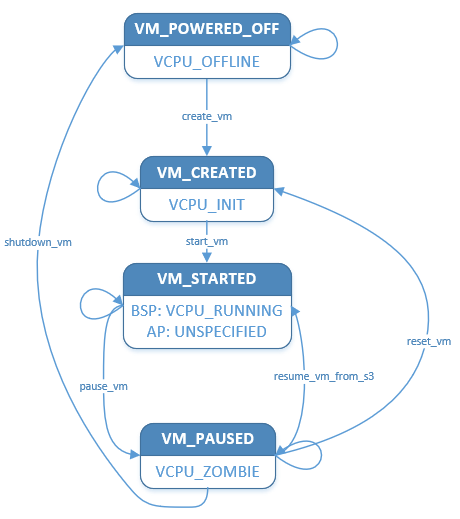VM Management¶
The ACRN hypervisor maintained a dedicated VM structure instance for each running VM, and a series VM APIs like create_vm, start_vm, reset_vm, shutdown_vm etc are used to switch a VM to the right state, according to the requirements of applications or system power operations.
VM Structure¶
The acrn_vm structure is defined to manage a VM instance, this structure
maintained a VM’s HW resources such as vCPU, vPIC, vIOAPIC, vUART, and vPCI.
At
the same time acrn_vm structure also records SW information
related with corresponding VM, such as info for VM identifier, info for SW
loader, info for memory e820 entries, info for IO/MMIO handlers, and info for
platform level cpuid entries.
The acrn_vm structure instance will be created by create_vm API, and then
work as the first parameter for other VM APIs.
VM State¶
Generally, a VM is not running at the beginning: it is in a ‘powered off’ state. After it is created successfully, the VM enters a ‘created’ state. Then the VM could be kicked to run, and enter a ‘started’ state. When the VM powers off, the VM returns to a ‘powered off’ state again. A VM can be paused to wait for some operation when it is running, so there is also a ‘paused’ state.
Figure 85 illustrates the state-machine of a VM state transition. Refer to CPU Virtualization for related vCPU state.

Figure 85 Hypervisor VM State Transition¶
VM State Management¶
Pre-Launched and Service VM¶
The hypervisor is the owner to control pre-launched and Service VM’s state by calling VM APIs directly, following the design of system power management. Refer to ACRN power management design for more details.
Post-Launched User VMs¶
DM takes control of post-launched User VMs’ state transition after the Service VM boots, by calling VM APIs through hypercalls.
Service VM user level service such as Life-Cycle-Service and tools such
as acrnd may work together with DM to launch or stop a User VM.
Refer to Acrnctl and Acrnd documentation for more details.